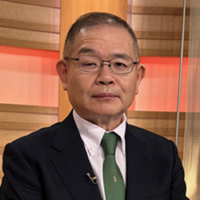There is no doubt about the fact that digital technologies will continue to play a central role in making society work as far into the future as one can imagine. But how to effectively use digital technologies has always been a major concern.
Hideki Wakabayashi, a professor of the Graduate School of Management at the Tokyo University of Science, wrote the 2022 book “Dejitaru Retto Shinkaron” (“Theory of Digital Japan Archipelago Evolution”), which discussed how Japan can solve mounting social issues and maintain its national strength by utilizing digital technologies and promoting the growth and prosperity of the industry.
In a recent interview with The Japan Times, Wakabayashi gave some concrete examples of how digital technologies have contributed and will continue to contribute to the lives and security of people, and the importance and progress of the domestic production of semiconductors that support these technologies.
Mitigating rural depopulation
“Attracting technology companies to rural areas has so far proven to be an effective solution to create new jobs and mitigate rural depopulation,” Wakabayashi said. He added that a good example is the city of Inzai, Chiba Prefecture, which has attracted data centers including those of global tech giants. He also suggested that the effect that semiconductor plants such as those built in Kumamoto Prefecture by Taiwan Semiconductor Manufacturing Co. can have on their locations may even be much greater than that of data centers.
The latest technologies can also contribute greatly to prefectural infrastructure.
“For example, what is necessary to create a hazard map based on an accurate simulation to each area’s vulnerability to disasters such as floods and earthquakes is artificial intelligence and a data center that can run it,” Wakabayashi said.
Due to the increasing severity of natural disasters in Japan, the security of people, including civil servants and those in position to protect the lives of citizens — such as emergency service workers — has been a major challenge. Wakabayashi pointed out that artificial intelligence can contribute to preventing people from risking their lives to save others by giving accurate and timely evacuation warnings based on constant learning.
Accidents resulting from human error may also be reduced by using new technologies. Wakabayashi explained that autonomous driving managed by the infrastructure side based on maps with road surface information and weather conditions could help reduce traffic accidents.
Sustainable data centers key
At the same time, Wakabayashi stressed the importance of digital infrastructure that can ensure the stable use of technologies. He said that a lack of capacity at data centers or stability of signals and information network when conducting activities such as remote surgery could result in risking people’s lives.
Data centers constitute a significant part of digital infrastructure. Wakabayashi said that the government has already decided on the plan to establish new bases for large data centers in Kyushu and Hokkaido in addition to the current ones in Tokyo and Osaka. However, he said the plan may not be enough.
Quoting a report by Keio University professor Jun Murai, Wakabayashi said data centers “should ideally be established in one or two locations in each prefecture, and ultimately in every municipality nationwide,” and explained that the argument is based on the fact that today’s data centers deal with artificial intelligence inference and learning, which consumes a vast amount of electricity, making it difficult to rely only on data centers in big cities. The key to producing and maintaining the efficiency and stability of data centers is semiconductors. But there is another concern about these items.
“I have been particularly concerned about Japan’s trade deficit in digital technologies. To mitigate the deficit, we need to nurture Japan’s competitiveness in manufacturing and rely less on imports,” he said. “Japan used to have half of the global market share of semiconductors in 1989. In the same year, eight companies in the world’s top 10 DRAM manufacturers were Japanese companies. One of the reasons why Japan was not able to maintain its position was Japan-U.S. trade friction,” Wakabayashi said.
However, in terms of logic semiconductors, Japan had never been strong. “In 1995, Japan’s share in the global production of logic semiconductors was only ¥1 trillion out of ¥7 trillion,” Wakabayashi pointed out. The global market for logic semiconductors grew rapidly since then, and it was the fabless and foundry model that brought about more efficiency and less cost in chip production in the world. Wakabayashi said that Japan continued its own old-school manufacturing, which involves the in-house production of everything either because it was ignorant of this major shift in the business model or it was too optimistic and did not take the change seriously.

“One of the areas where Japan has continued to lead the world is image sensors, in which Sony excels. The company has almost half of the global market. Japan is also still strong in analog power semiconductors, producing about one-fourth of the total production worldwide. This is the area that will attract increasing attention with the rise of electric vehicles,” Wakabayashi said. He went on to say that certain kinds of memory chips are also promising, namely NAND-type flash memory used in generative AI. “In terms of NAND flash memory, the partnership between Kioxia and Western Digital is securing about 30% of the global market.
He also pointed out that Japan has continued to be one of the major manufacturing countries in terms of chip manufacturing equipment and materials. Tokyo Electron Ltd. and Screen Holdings specialize in manufacturing equipment, while Shin-Etsu Chemical, Sumco and Resonac produce materials.
Focus on chiplet technology
But how can Japan join the race to produce cutting-edge logic semiconductors, an area where it has had almost no presence?
“That is what Rapidus is focusing on, to try creating smaller than two-nanometer-size chips. With the new EUV (extreme ultraviolet) exposure equipment installed soon, the company will accelerate preparations to start the mass production of logic semiconductors in 2027,” Wakabayashi said.
But mass production at Rapidus will be much smaller than at companies like TSMC. The strength of Rapidus is its ability to produce diverse kinds of chips in small lots in short periods of time. He pointed out that companies like Rapidus can increase their profits by going beyond nanoscale, shortening the turnaround time.
The technology he takes particular note of as a means to achieve higher efficiency and profitability is chiplet technology, which is what Rapidus is incorporating as well. A chiplet is a silicon die optimized for a specific function or task, and it can be easily assembled into a package with other chiplets to operate as a larger and more complex system. This is more efficient and cost effective than building a large monolithic die designed to perform multiple functions; these are facing limitations in yield rate as chips shrink.
In addition to chiplet technology, Rapidus has another strong advantage, which is global expectations as concern grows over China’s disturbing moves. “In that regard, the project of Rapidus is actually a contribution to the international community,” he said.
Viable supply a must
He went on to say that the next challenge for Japan would be to gain the capacity to produce SiC (silicon carbide) wafers domestically. This material is mostly used in 5G communications equipment, smart grids, electric vehicles and other advanced technologies.
“There is an ongoing project funded by the Green Innovation Fund, which was established by the New Energy and Industrial Technology Development Organization to develop new ways to make SiC wafers,” he said. He explained that the project is trying various approaches such as those using the solution growth method or high-temperature gas, which could prove more stable than the current sublimation method. “It is looking promising with some achievements being made in these approaches,” he said.
For society to continuously receive the benefit of digital technologies, stable supply and accelerated advancement of semiconductors is a must, but it has never been free from geopolitical concerns.
Wakabayashi’s insights suggest that Japan can and should play a key role in the global semiconductor market while aiming to achieve higher self-sufficiency in digital technologies to solve its own social issues.





